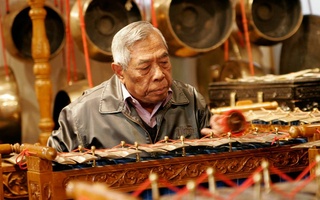Jody Diamond does not allow spectators at her weekly Gamelan rehearsals. If you come, you play.
Held in the Student Organization Center at Hilles every Tuesday at 6:30 p.m., Gamelan lessons take place in a small room decorated with bright orange and blue percussion instruments, as well as an assortment of drums, painted mallets, and a couple of large gongs in the back corner.
Gamelan, pronounced jam-eh-lan, is a traditional instrumental ensemble from Indonesia that boasts a small but vibrant community at Harvard. The ensemble, led by Harvard artist-in-residence Jody Diamond, is composed of students, musicians, and local residents.
Players are instructed to discard their shoes in a pile in the corner and take their seats on small stacks of blue cushions. At this Tuesday’s rehearsal, Diamond’s white poodle Lily was in attendance and ambled among the instruments.
Once warmed up, the players, separated by percussion instruments on all four sides, begin to harmonize. Although gamelan music relies on a basic skeletal structure, the core of its appeal lies in improvisation. Beginning and ending with a certain contour of notes, gamelan music moves not so much around pitch and rhythm as around the contour of how the notes flow.
T. Brandon Evans, a second year film and visual studies Ph.D. student at Harvard Graduate School of Arts and Sciences, has been playing gamelan for a year, and said that he finds it the perfect way to relax.
“Once you understand the contour, you just feel the vibration,” Evans said. “You’re able to relax and just play.”
As a researcher of theories of sound, Evans also said he finds gamelan an interesting way to reverse conceptions of time. Because gamelan rhythm is punctuated by the intermittent strikes of the gong and the tenong—a xylophone-like percussion instrument with triangular keys—players draw their timing not from measured beats but from listening to the ensemble as a whole.
Diamond, who has been playing gamelan since 1970, said she loves this fluid notion of time and the culturally specific way of listening that gamelan teaches.
“Playing gamelan offers a different way for us to hear time, to connect with each other, and to uncover feelings that we didn’t know existed before,” Diamond said. “It’s a totally new way of relating and discovering.”
Diamond believes that the appeal of the gamelan, especially at Harvard, is that unlike other activities, gamelan affords students the freedom to be a total beginner and to make mistakes.
“We didn’t grow up hearing music this way,” Diamond said. “We’re like little children. Learning the gamelan is like watching yourself learn English as a baby. That’s why I fell in love.”
Recommended Articles
-
Leiter Cup Baseball.The Leiter Cup games scheduled for yesterday resulted as follows: Fakes 8, Texas Leaguers 5; Indians 11. Sky Pilots 3;
-
Results of Leiter Cup Baseball GamesThe preliminary round of the Leiter Cup series was continued on Soldiers Field yesterday afternoon. Two games were played, the
-
No HeadlineA base-ball diamond, smaller than the regulation size, has been laid out in the depot in which the University of
-
 Gamelan, Making Music in Hilles
Gamelan, Making Music in Hilles -
 World Music Gives Cultural Studies a Voice
World Music Gives Cultural Studies a Voice













